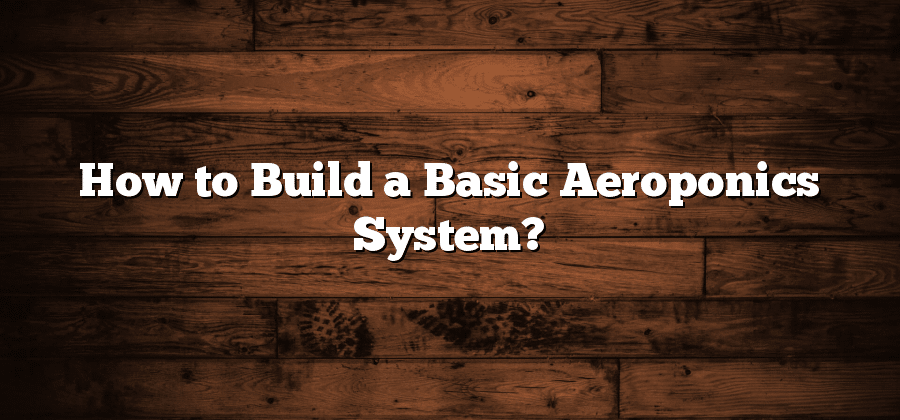Understanding the Principles of Aeroponics
Aeroponics is an innovative and efficient method of growing plants that has gained popularity in recent years. Unlike traditional soil-based cultivation or hydroponics, aeroponics involves suspending plant roots in the air and misting them with a nutrient-rich solution. This allows the roots to receive an optimal amount of oxygen, promoting fast and healthy growth. The key principle behind aeroponics is the use of a highly oxygenated environment, which stimulates root development and enables plants to absorb nutrients more effectively. This method eliminates the need for soil or solid substrates, making it a space-saving and environmentally friendly option for growing a wide range of crops.
Selecting the Right Materials for Your Aeroponics System
When it comes to selecting the right materials for your aeroponics system, there are a few key factors to consider. First and foremost, you’ll want to choose materials that are durable and long-lasting. Aeroponics systems require constant moisture and can put a strain on certain materials, so opting for high-quality components is essential to ensure the longevity of your system.
In addition to durability, it’s crucial to select materials that are compatible with plants and safe for food production if you plan to grow edible crops. Look for materials that are BPA-free and food-grade, such as PVC or HDPE pipes, which are commonly used in aeroponics systems. Avoid using materials that may contain harmful chemicals or toxins that could potentially leach into the water and affect the health of your plants.
Moreover, it’s important to consider the availability and cost of materials. While some types of equipment may be more expensive initially, they may offer greater efficiency or durability in the long run. On the other hand, using cheaper materials may save you money upfront, but they could be more prone to breakage or require frequent replacement, resulting in higher expenses over time. Balancing cost and quality is crucial to ensure you can build a reliable and cost-effective aeroponics system.
Designing the Layout and Structure of Your Aeroponics System
The layout and structure of your aeroponics system play a crucial role in its overall efficiency and productivity. Before designing the layout, it is important to consider the available space, the number of plants you plan to grow, and the specific requirements of each plant.
When designing the layout, ensure that there is enough space between the plants to allow for adequate airflow and proper distribution of the nutrient-rich mist. This will help prevent the growth of mold or diseases that can hinder plant growth. Additionally, consider the accessibility of the system for maintenance and harvesting purposes. Installing a drip tray or a raised platform can help minimize the risk of water damage to the surrounding area.
Building the Reservoir and Pumping System for Your Aeroponics System
One crucial component of your aeroponics system is the reservoir and pumping system. This is where your nutrient solution is stored and circulated to deliver the necessary nutrients to your plants. When building the reservoir, it is essential to choose a material that is durable, non-toxic, and resistant to corrosion. Common options include food-grade plastic containers or specially designed water tanks. Ensure that the reservoir has a sufficient capacity to hold an ample amount of nutrient solution for your plants’ needs.
Aside from the reservoir, the pumping system is responsible for delivering the nutrient solution to the roots of your plants effectively. It is crucial to select a pump that is reliable and capable of delivering a consistent flow of mist or droplets. Submersible pumps are commonly used in aeroponics systems, as they can handle both the nutrient solution and high-pressure misting needs. When installing the pump, be sure to position it correctly to ensure optimal distribution of the mist or droplets to all the plants in the system.
Creating the Aerochamber and Mist Delivery System
When it comes to creating the aerochamber for your aeroponics system, there are a few key factors to consider. First and foremost, it is important to design the aerochamber in a way that allows for efficient mist delivery to the plant roots. This can be achieved by ensuring that the chamber is sealed properly to prevent any leaks or loss of mist. Additionally, the size of the aerochamber should be appropriate for the number of plants you plan to grow, allowing enough space for each plant to receive an adequate amount of mist.
In terms of the mist delivery system, there are a few options to consider. One option is to use a fine mist nozzle that can be attached to the chamber. This nozzle should be able to produce a fine mist that evenly covers the plant roots without causing any damage. Another option is to use a fogger system, which creates a fog-like mist that can also effectively deliver moisture to the plants. Whichever option you choose, it is important to regularly maintain and clean the mist delivery system to ensure proper functioning and prevent clogging.






